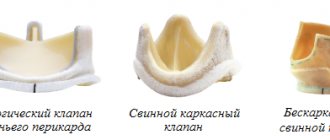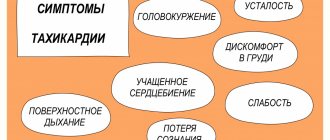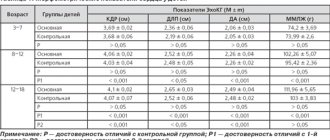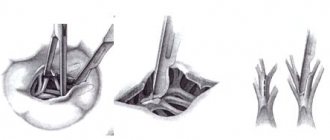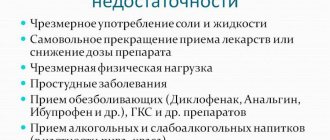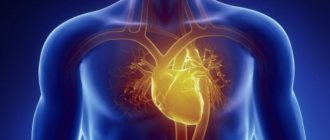The movement of blood flow from one chamber of the heart to another occurs in one direction. The reverse movement is prevented by valves (bicuspid and tricuspid), which close during systole. Incomplete closure of the atrioventricular orifice between the ventricular and atrial cavities leads to disruption of blood regulation, the severity of which varies from asymptomatic to severe.
Characteristic ailments: weakness, rapid heartbeat, pressing pain in the heart, shortness of breath, cyanosis.
In Israeli clinical treatment of children with tricuspid valve dysfunction is carried out in accordance with the established degree and is aimed at eliminating heart failure.
| Our pediatric cardiology department, staffed by highly qualified specialists, is equipped with the latest equipment that allows us to promptly identify the problem and eliminate it as effectively as possible.. |
Statistics and prognosis for the treatment of tricuspid valve insufficiency in children in Israel
Defective valve function detected in the first years of life is most often a congenital anomaly (organic) and, as a rule, not isolated.
The acquired form (relative or functional, not associated with deformation of the valve leaflets) is caused by diseases that result in the development of rheumatic pathologies. Such a lesion is recognized in 15–30% of cases.
A child with severe tricuspid valve insufficiency, especially in combination with other severe myocardial pathologies, develops serious complications that require immediate treatment, which is successfully carried out in the best clinic in Israel, Hadassah . In addition, corrective or therapeutic measures are required for all types of congenital heart disease.
| Otherwise, once diagnosed, the five-year survival threshold is rarely surpassed. |
The prognosis of therapy depends on the severity of reverse blood flow (there are 4 degrees), damage to the myocardium itself, and the severity of associated complications. The rich experience and professional skills of the doctors at our medical center allow us to adequately assess the condition of a small patient and, if appropriate, select effective drug treatment. But the prospects of the technique are considered short-lived, since the medicinal effect can stabilize well-being, without excluding the progression of the disease. The mortality rate remains high.
Without timely assistance from cardiac surgeons, not only stagnation in the body, but also irreversible processes can develop.
Open heart surgery carries an increased risk but has a better prognosis. Mortality after surgery is 1–3%, and for plastic surgery this figure is lower than for prosthetics (about 14% of the total).
Possible reasons for the appearance
There are many reasons for the development of tricuspid insufficiency. The most common of them include:
- Rheumatism is an autoimmune inflammation that often affects the valves. It may occur 1-2 weeks after a sore throat (tonsillitis) caused by a special beta-hemolytic streptococcus. This is the most common cause not only of heart failure, but also of many other acquired heart defects in children.
- Infectious endocarditis is an acute pathology of the inner lining of the heart, which is sometimes called “injection drug addicts’ disease” due to the high risk of infection during unscrupulous injection. But it can also develop due to poor antiseptic treatment of the skin during an unprofessional procedure.
- Mitral valve (MV) defects - MV insufficiency or mitral orifice stenosis often occur as a consequence of tricuspid valve pathology.
- Diseases of the respiratory system - chronic obstructive pulmonary disease, bronchial asthma.
- Congenital heart defects - Ebstein's anomaly.
- Cardiac diseases - cardiomyopathies, myocardiosclerosis.
- Increased pulmonary artery pressure.
More rare causes of TC deficiency:
- Use of medications - some medications can have a destructive effect on the valves, for example, the migraine drug Methysergide or the diet pills Fenfluramine.
- Exposure to ionizing radiation —radiation therapy for the treatment of malignant tumors.
- Hereditary diseases manifested by a connective tissue defect are Ehlers-Danlos syndrome, Marfan syndrome, undifferentiated dysplasia.
- Carcinoid tumors. With neuroendocrine neoplasms located in the organs of the gastrointestinal tract, the tricuspid valve is often affected for unknown reasons.
- Rheumatic diseases - rheumatoid arthritis, systemic lupus erythematosus, systemic scleroderma, dermatomyositis.
- Whipple's disease is a very rare chronic intestinal infection that can be complicated by endocarditis.
Symptoms and diagnosis of tricuspid valve insufficiency in children in Israel
The etiology of tricuspid valve dysfunction differs into primary and secondary, that is, congenital (organic) and acquired (functional). In the first case, the valve leaflets are affected, they become deformed, wrinkled or calcified. In the second, the valve apparatus is damaged (papillary muscles, chordae tendineae, fibrous ring).
Signs of tricuspid insufficiency:
- blue-yellow complexion;
- puffiness;
- dyspnea;
- cardiopalmus;
- rapid fatigue with low load;
- pain and feeling of heaviness in the right hypochondrium;
- pulsation of neck veins;
- flatulence;
- nausea, vomiting.
In addition to external symptoms, the patient exhibits stagnation in the circulatory system, which is manifested by the accumulation of fluid in the pleural cavity, edema, ascites, and enlarged liver.
| To make an accurate diagnosis, Hadassah doctors prescribe a comprehensive examination. |
Before starting an instrumental or hardware study, the cardiologist conducts a physical examination, analyzes the nature of complaints of malaise and inquires about previous diseases.
The whole process takes from 3 to 7 days. The diagnostic findings brought with you are reviewed, after which an additional check is performed. The laboratories of the Hadassah MC are equipped with high-precision equipment, which eliminates false diagnoses. Often, previously identified pathology is not confirmed.
The following are prescribed for examination:
- Auscultation - listening allows you to determine the heart tone and the presence of arrhythmia.
- Electrocardiogram (ECG) - determines hypertrophy or overload of the right heart chambers, rhythm and conduction disturbances (AV block, tachycardia, atrial fibrillation), the size of the right atrium and ventricle.
- Phonocardiogram - reveals systolic murmur.
- X-ray - detects changes in the size of the atrium and vena cava.
- Echocardiography (EchoCG) is an ultrasound method for recognizing regurgitation, morphological and functional changes in the myocardium and valvular apparatus accompanying congenital heart disease.
- Computed tomography (CT) - the study allows you to study the organ from different angles, accurately visualizes all parameters, and, if necessary, displays a section in any plane.
The completeness of the clinical picture is complemented by the collection of tests (CBC, OAM, biochemical and immunological tests), which can indicate the inflammatory process, deviations from standard indicators in case of damage to internal organs, the content of antibodies and C-reactive protein.
After studying the results of the diagnostic course, the medical council draws up a treatment plan.
Diagnostics: Ultrasound criteria and other methods
When examining a person with tricuspid regurgitation, I should look for the following signs:
- increased and diffuse pulsation in the epigastric region, which occurs due to pronounced thickening and expansion of the right ventricle;
- enlarged and pulsating liver;
- a very characteristic symptom of right ventricular CHF is hepatojugular reflux (when I put pressure on the liver, the jugular veins begin to swell greatly);
- When listening to the heart, you may encounter a prolonged systolic murmur on the xiphoid process at the lower edge of the sternum (this cartilage is located in the epigastric region).
My main instrumental method for diagnosing tricuspid insufficiency is echocardiography (Echo-CG, ultrasound of the heart). Her main criteria for the final verdict:
- regurgitation of blood into the right atrium;
- the width of the regurgitant jet is more than 7 mm;
- the area of the regurgitation opening is more than 40 mm2;
- expansion of cavities and thickening of the muscle layer of the pancreas and RA;
- increased pulsation of the dilated inferior vena cava.
Also, one of the criteria for the presence of the disease is reverse blood flow in the hepatic veins. On the ECG film, I quite often find signs of overload of the right side of the heart, namely:
- hypertrophy of the RA and RV: high pointed P wave in leads II, III, aVF (the so-called “P-pulmonale”), high R waves in leads I, II, deep S waves in leads V5, V6;
- incomplete blockade of the right bundle branch;
- atrial fibrillation (atrial fibrillation).
To better track rhythm disturbances, I conduct Holter (24-hour) ECG monitoring, since many arrhythmias are attack-like (paroxysmal) and may not be detected on a regular cardiogram.
Modern methods of treating tricuspid valve insufficiency in children in Israel
The pediatric cardiology department at Hadassah is headed by Dr. Azariah Rein. After receiving higher medical education at the Hebrew University, he trained at the Shaare Zedek Clinic. After receiving his degree, he became a university professor in Jerusalem and Harvard. Permanent member of the Academic Council of Israel, engaged in scientific research.
Cardiac surgery is under the direction of Professor Eldad Erez, holder of two higher qualifications, specializing in the treatment of congenital defects in children. The future doctor of medicine's internship took place in Haifa and Beilinson, his residency in Atlanta (USA), where the doctor mastered the technology of heart transplantation. Erez teaches medical students in Tel Aviv and Jerusalem, and is the author of scientific works.
The first day after hospitalization in the hospital is reserved for examination, medical history, and documentation in Hebrew. Throughout the entire stay in the hospital, the little patient and his parents are accompanied by a Russian-speaking consultant.
Treatment for tricuspid valve insufficiency in children is selected strictly on an individual basis and depends on the degree of regurgitation of blood flow (1, 2, 3 or 4):
- 1 - subtle throw or touch of the tricuspid valve;
- 2 — reverse ejection is determined at a distance of 2 cm from the atrioventricular opening;
- 3 — return of blood from the right ventricle to a distance of more than 2 cm;
- 4 - regurgitation in the right atrium over a significant extent.
The first stage may be limited to medical observation or conservative therapy. Starting from the second, the nature of the intervention will depend on the intensity of casting, complications caused by the defect, and the presence of combined anomalies.
Elimination of the defect and the consequences of improper functioning of the heart is carried out through medication or surgery.
Drug therapy
The conservative approach includes drugs that ease the work of the heart and reduce pulmonary hypertension. This list includes diuretics, anticoagulants, b-blockers, glycosides, drugs that increase metabolism, and ACE inhibitors.
Surgical intervention
The main types of surgical techniques are repair of the patient's own valve or prosthetics using a bioprosthesis or a mechanical analogue.
Indications for prosthetics are considered to be severe changes in the valves. The material for the manufacture of a biological prosthesis is the aorta of an animal (pig). Unlike a mechanical one, a bioprosthesis significantly reduces the development of thromboembolism, but lasts only 10 years, requiring repeated replacement.
Preference is given to plastic correction, but only if no pronounced changes in the structure of the valves are detected. The obvious advantages of this procedure are minimal postoperative complications and a reduction in the rehabilitation period. In addition, restoration using one’s own, normally functioning tissues increases resistance to infections and eliminates the need for constant use of special medications.
Types of pathology
There are two types of TC deficiency:
- Organic , which occurs as a result of morphological changes in the valve leaflets (wrinkling, fibrosis, degeneration) with rheumatism, endocarditis, connective tissue diseases, etc.
- The functional form is three times more common than the organic form. In her case, the valve structure is not damaged. Failure occurs due to increased pressure in the right ventricle, which causes the valve fibrous framework to expand and the leaflets cannot close completely. This type of tricuspid valve defect is observed in combination with mitral heart defects and other pathologies: with pulmonary hypertension, severe bronchial asthma (i.e., with conditions leading to overload and increased pressure in the RV).
Rehabilitation after treatment of tricuspid valve insufficiency in children
The recovery period takes place in the specialized rehabilitation department of the Hadassah MC. They use a modern approach and innovative technologies that promote a speedy recovery and return to a full life.
To prevent negative consequences upon discharge, Israeli cardiologists recommend following certain requirements:
- follow all doctor's instructions;
- refuse self-medication;
- exclude independent withdrawal of medications or changes in their dosage;
- After complete recovery, start hardening the child.
The equipment of the rehabilitation center allows both children and their accompanying persons to stay comfortably in our institution.
Characteristic symptoms
Manifestations depend on the stage of the pathological process. A hemodynamically insignificant variety has no signs at all.
Typical signs in other situations include:
- Liver lesions. They make themselves known in the later stages. They are determined by pain in the right hypochondrium, an increase in the size of the organ, and yellowness of the skin due to excess bilirubin. A gradual formation of insufficiency is possible.
- Abdominal pain of unknown localization. Wandering, radiating to the iliac regions. Acute discomfort is not typical, therefore it is impossible to confuse it with the clinical picture of appendicitis.
- Shortness of breath for no apparent reason. It develops first against the background of intense physical activity, then occurs in a state of complete rest. Significantly reduces quality of life.
- Polyuria. As a result of developing renal failure. At later stages (3-4), with primary damage to the excretory system, it is replaced by a reverse process. Daily diuresis is 500 ml or less.
- Tachycardia. The heart rate reaches 120-150 beats. They are full-fledged, regular. Type - sinus. Less often paroxysmal.
- Weakness, lack of ability to work.
- Feeling of constant cold. The patient freezes because the intensity of peripheral circulation decreases.
- Increased pressure in the veins. Objectively, the symptom is manifested by swelling of the cervical vessels, their intense pulsation, and visible tension. Not only the doctor, but also the patient himself or the people around him can determine the sign. However, blood pressure drops in most cases. Not significant, however, clinical significance is present.
- Swelling of the lower extremities. As a logical continuation of increasing renal failure.
- Breathing problems.
As a result, the patient has a whole range of symptoms from both distant organs and systems, and the cardiac structures themselves. The reason for all the sensations lies in the disruption of blood circulation, both in the large and in the small circle.
How much does it cost to treat tricuspid valve insufficiency in children in Israel?
Hadassah is considered one of the best medical institutions in Israel. The most effective methods for recognizing and combating children's heart defects are being developed and implemented here; qualified senior and mid-level physicians work here.
The administration of the medical complex has a competitive pricing policy, so our cost of stay is average across the country and is 20–30% lower than in Europe and America. In addition, all prices are controlled by the Israeli Ministry of Health.
Treatment: methods and indications
The primary task of doctors is to eliminate the cause of valve failure.
Drug therapy has several directions:
- combating CHF and slowing its progress as much as possible;
- prevention and treatment of heart rhythm disorders;
- prevention of thrombosis.
I use the following medications to treat heart failure:
- beta-blockers - “Bisoprolol”, “Metoprolol”;
- ACE inhibitors - Perindopril, Lisinopril;
- aldosterone antagonists, or potassium-sparing diuretics - Spironolactone.
For edema, I use more powerful diuretics - Torasemide, Indapamide. If too much fluid accumulates in the cavities (thoracic, abdominal) or pericardial sac, I consult with surgeons about pumping it out. Depending on the cavity from which excess is removed, the following procedures are distinguished: pleural puncture, laparocentesis, pericardial puncture.
For the treatment of arrhythmias, antiarrhythmic drugs are prescribed - Amiodarone, Propafenone. To prevent thrombus formation and avoid pulmonary embolism or stroke in patients with atrial fibrillation, I use anticoagulants - Warfarin, Dabigatran, Rivaroxaban.
How to get treatment in Israel
By choosing our multidisciplinary complex, you get the opportunity to visit the right specialists and undergo all types of diagnostics in one place. Our own developments and exchange of experience with foreign partners make our clinic one of the best in the world.
To avoid the costs of intermediaries, use our official website. You can submit a request to visit the children's cardio center by filling out an electronic form. A Russian-speaking representative of the international department will contact you within two hours and answer all questions.

